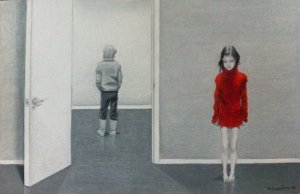This is one of those rare cases where the book can not compare artistically with its movie adaptation. Sure, John Ajvide Lindqvist’s “Let the Right One In” has more detail, and even works to a certain extent. But I actually think the movie was improved somewhat by being stripped down to its bare essentials, and eliminating extraneous subplots. The book is a pretty good read, but it hardly seems to be in league with the masterpiece the Swedish film version was.
Twelve-year-old Oskar Eriksson is a bullied misfit kid who wants to get back in a big way at his cruel tormentors. He is a overlooked resident of Blackeberg, whose surrounding areas have been plagued by a series of ritualistic killings. Oskar is fascinated by the sense of unease and the corresponding murders and even keeps a scrapbook containing clips of violent crimes. Neither Oskar’s fragile mother or his alcoholic, divorcee dad seem to notice Oskar is harboring a Antisocial streak. But when you’re afraid to go to school every day, life can do that to you.
Then Oskar meets Eli, a strange, thin, androgynous child who encourages him to fight back against his bullies. Eli’s frail façade hides an insatiable bloodlust, but Oskar finds himself strangely drawn to her. How far will Oskar go to protect Eli’s secret? “Let the RIght One In” is a compelling take on vampire lore, but I think it tries too hard to scientifically explain vampirism. Some things are better left unsaid.
The book also offers descriptions of what it feels like to be bitten by a vampire and to turn into a vampire, which is pretty cool. However, it also contains too many characters and feels unnecessarily long. Some passages better explain things left ambiguous in the film, like the role of Eli’s caretaker, Hakan, or the relationship between Oskar and his dad.
In the film, Oskar had a certain innocence and vulnerability that mad him very compelling, despite the indisputable fact that he was a very troubled little boy. The child actor gave that innocence creditability. In the book, Oskar is mostly creepy, someone you don’t want to meet in a dark alley despite his youth and small stature. In this novel, Oskar harbors a fantasy of seeing someone executed in an electric chair and even sets some desks in his classroom on fire (okay, his bullies’ desks, but still, that’s a big safety hazard!)
Oskar still certainly isn’t a completely unsympathizable character, but maybe you have more of a propensity to feel for him when you aren’t looking into that troubled little mind of his. Eli, however, is as compelling as ever, and you get a better sense of who she is the novel, as well as get a more complex look into the grey areas in between the elements of her ambiguous gender.
There’s is some interesting further development of the side characters, but mostly the wealth of detail on the supporting players seems a little ‘meh.’ Despite my quibbles, this book may be still worth reading if you want a more complete picture of a story that proves the vampire genre is not dead. The murderous, predatory class of vampires, not the sparkling one.

















